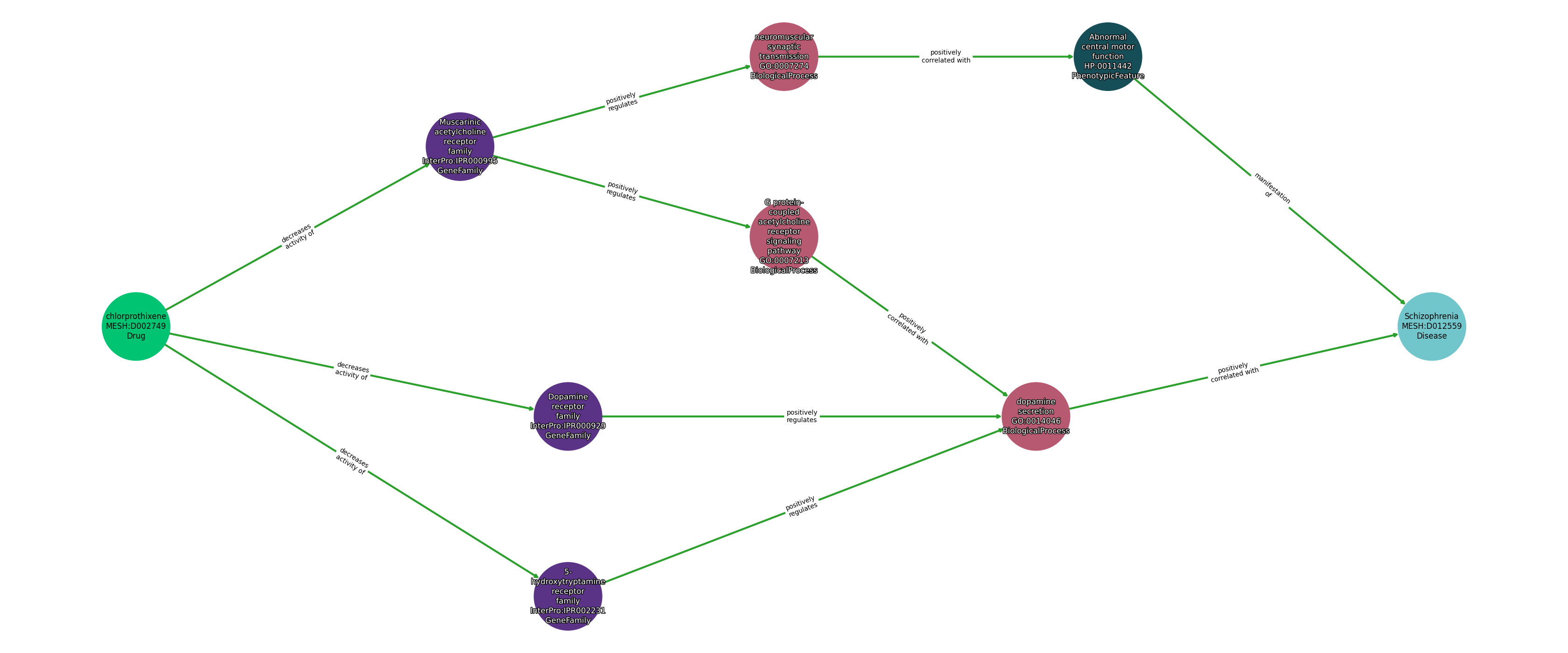Path ID: DB01239_MESH_D012559_1

Concepts
| Identifier | Name | Type |
|---|---|---|
| MESH:D002749 | chlorprothixene | Drug |
| InterPro:IPR000995 | Muscarinic acetylcholine receptor family | GeneFamily |
| InterPro:IPR002231 | 5-hydroxytryptamine receptor family | GeneFamily |
| InterPro:IPR000929 | Dopamine receptor family | GeneFamily |
| GO:0014046 | dopamine secretion | BiologicalProcess |
| GO:0007274 | neuromuscular synaptic transmission | BiologicalProcess |
| GO:0007213 | G protein-coupled acetylcholine receptor signaling pathway | BiologicalProcess |
| HP:0011442 | Abnormal central motor function | PhenotypicFeature |
| MESH:D012559 | Schizophrenia | Disease |
Relationships
NOTE: predicates are annotated in Biolink Model (v1.3.0)
| Subject | Predicate | Object |
|---|---|---|
| Chlorprothixene | DECREASES ACTIVITY OF | Muscarinic Acetylcholine Receptor Family |
| Chlorprothixene | DECREASES ACTIVITY OF | Dopamine Receptor Family |
| Chlorprothixene | DECREASES ACTIVITY OF | 5-Hydroxytryptamine Receptor Family |
| Muscarinic Acetylcholine Receptor Family | POSITIVELY REGULATES | Neuromuscular Synaptic Transmission |
| Neuromuscular Synaptic Transmission | POSITIVELY CORRELATED WITH | Abnormal Central Motor Function |
| Abnormal Central Motor Function | MANIFESTATION OF | Schizophrenia |
| 5-Hydroxytryptamine Receptor Family | POSITIVELY REGULATES | Dopamine Secretion |
| Muscarinic Acetylcholine Receptor Family | POSITIVELY REGULATES | G Protein-Coupled Acetylcholine Receptor Signaling Pathway |
| G Protein-Coupled Acetylcholine Receptor Signaling Pathway | POSITIVELY CORRELATED WITH | Dopamine Secretion |
| Dopamine Receptor Family | POSITIVELY REGULATES | Dopamine Secretion |
| Dopamine Secretion | POSITIVELY CORRELATED WITH | Schizophrenia |
Comment: Muscarinic receptor antagonists (also known as anticholinergics) seem to be used in patients with Schizophrenia to alleviate motor side effects caused by first-generation antipsychotics. However these antagonists do seem to lead to cognitive dysfunction in healthy controls. So whether these muscarinic receptors should be positively or negatively regulated in schizophrenia is a matter of debate (see https://www.nature.com/articles/4001924 https://www.ncbi.nlm.nih.gov/pmc/articles/PMC3726271/)..) In addition, some suggest that that schizophrenia involves an overactivation of cholinergic neurons, which could provide cholinergic input to dopaminergic neurons. The dopamine neurons are located in the mesolimbic dopaminergic system (BTO:0005591), which is a component pathway of the medial forebrain bundle (UBERON:0001910). See https://en.wikipedia.org/wiki/Medial_forebrain_bundle#Anatomy for more details.
Reference:
- https://go.drugbank.com/drugs/DB01239#mechanism-of-action
- https://go.drugbank.com/drugs/DB01239#BE0000092
- https://www.targetvalidation.org/summary?drug=CHEMBL908
- https://en.wikipedia.org/wiki/Antipsychotic#Mechanism_of_action
- https://en.wikipedia.org/wiki/Mesolimbic_pathway#Relation_to_neurological_and_psychological_disorders
- https://en.wikipedia.org/wiki/Schizophrenia#Medication